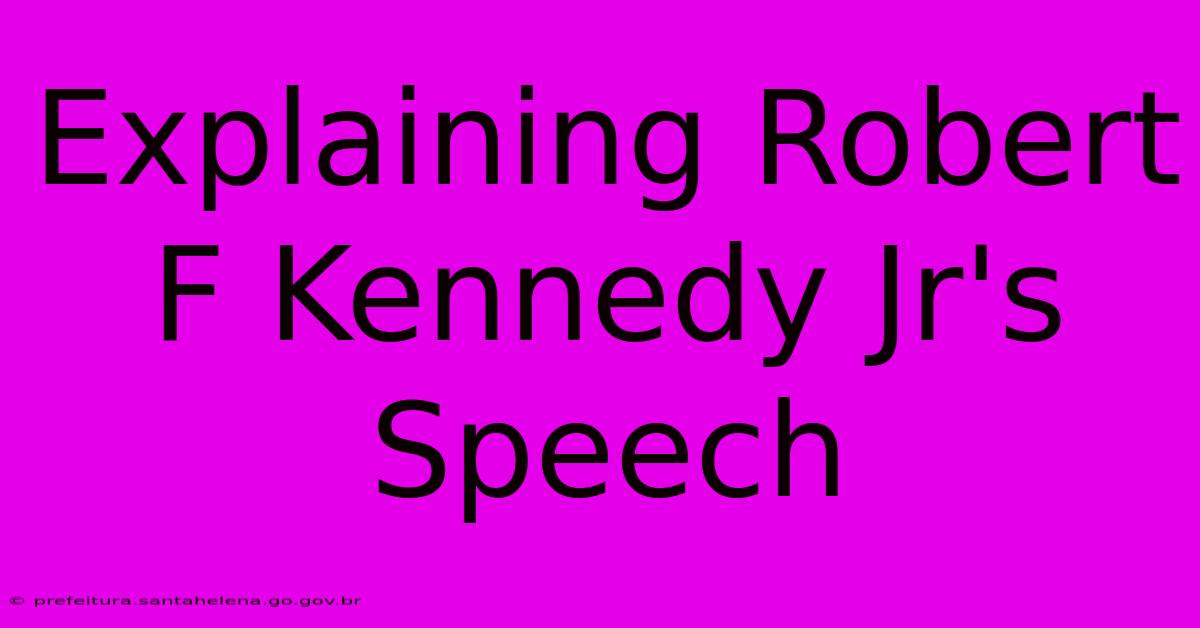Explaining Robert F Kennedy Jr's Speech

Discover more detailed and exciting information on our website. Click the link below to start your adventure: Visit Best Website. Don't miss out!
Table of Contents
Deconstructing Robert F. Kennedy Jr.'s Rhetoric: A Deep Dive into His Speeches
Robert F. Kennedy Jr.'s speeches are characterized by a potent blend of charisma, controversial claims, and a deeply ingrained narrative centered around the power of the individual against perceived systemic injustices. Understanding his rhetoric requires dissecting its various components: his chosen narrative structure, his appeals to emotion, his use of evidence (or lack thereof), and the overall impact his words have on his audience. This analysis will explore these facets, examining both the persuasive power of his speeches and the potential pitfalls of his approach.
The Central Narrative: A David vs. Goliath Tale
Kennedy's speeches often follow a classic David vs. Goliath structure. He casts himself as a champion of the people, fighting against powerful, corrupt institutions – be it Big Pharma, the mainstream media, or the government itself. This framing instantly resonates with audiences who feel marginalized or distrustful of authority. He paints a picture of a world where the powerful manipulate information and suppress dissent, leaving ordinary citizens vulnerable. This narrative taps into a deep-seated societal anxiety about power imbalances and corporate influence.
Mastering the Art of Emotional Appeal:
Kennedy is a master of emotional appeals, effectively leveraging pathos to connect with his audience on a personal level. He employs several rhetorical techniques to achieve this:
-
Anecdotes and Personal Stories: He frequently incorporates personal anecdotes and stories of individuals allegedly harmed by the systems he criticizes. These narratives humanize abstract issues, making them more relatable and emotionally resonant. The power of a well-told story bypasses critical thinking and taps directly into empathy.
-
Fear and Anger: He skillfully uses fear-mongering tactics, highlighting potential dangers and threats to emphasize the urgency of his message. This is particularly evident in his speeches concerning vaccine safety, where he paints a grim picture of a world overrun by preventable diseases and health crises. Similarly, he frequently evokes anger by exposing perceived injustices and conspiracies, igniting audience outrage.
-
Hope and Empowerment: While employing fear and anger, he also balances this with a message of hope and empowerment. He portrays himself and his followers as the vanguard of resistance, capable of overcoming powerful adversaries through collective action. This offers a sense of purpose and agency to his audience, strengthening their connection to his cause.
The Questionable Use of Evidence:
While Kennedy's rhetorical skills are undeniable, his use of evidence is often a point of contention. He frequently cites studies and reports selectively, omitting crucial context or relying on sources that lack scientific rigor. This approach raises concerns about the accuracy and reliability of his claims. He often conflates correlation with causation, presenting anecdotal evidence as definitive proof of causal relationships. This selective use of evidence, while effective in a rhetorical context, undermines the credibility of his arguments for those who scrutinize the facts.
Analyzing the Impact and Influence:
The impact of Kennedy's speeches is multi-faceted. For his supporters, his speeches are a source of comfort, validation, and empowerment. They feel heard and understood, finding a voice in his articulation of their concerns and grievances. This fosters a strong sense of community and shared identity amongst his followers.
However, his rhetoric also carries significant risks. The propagation of misinformation and conspiracy theories, even unintentionally, can have damaging consequences. The spread of false information can lead to decreased vaccination rates, the erosion of trust in scientific institutions, and the polarization of public discourse.
Beyond the Rhetoric: Understanding the Underlying Message
Beyond the specific claims made in his speeches, a deeper message emerges – a distrust of established power structures and a belief in the power of individual agency. This resonates with a growing segment of the population who feel alienated from mainstream politics and institutions. This sentiment, while understandable, needs careful consideration. While challenging established power is crucial for societal progress, it's equally important to ensure that such challenges are based on factual information and constructive engagement.
Conclusion:
Robert F. Kennedy Jr.'s speeches are masterful examples of rhetoric, effectively leveraging narrative, emotional appeals, and a sense of righteous indignation to connect with his audience. However, a critical analysis reveals a reliance on questionable evidence and a potential for the spread of misinformation. Understanding the intricacies of his rhetoric – its strengths and weaknesses – is crucial for evaluating the impact of his message and engaging in informed discussions about the complex issues he addresses. Ultimately, assessing his speeches requires a discerning eye, distinguishing between powerful oratory and substantiated facts. The captivating nature of his presentations shouldn't overshadow the need for critical engagement and a commitment to evidence-based truth.

Thank you for visiting our website wich cover about Explaining Robert F Kennedy Jr's Speech. We hope the information provided has been useful to you. Feel free to contact us if you have any questions or need further assistance. See you next time and dont miss to bookmark.
Also read the following articles
| Article Title | Date |
|---|---|
| Top Aanval Champions League Fc Barcelona | Jan 31, 2025 |
| Gerrard Faces 10m Uk Tax Bill | Jan 31, 2025 |
| American Airlines Crash 64 Passengers Black Hawk | Jan 31, 2025 |
| Robert F Kennedy Jrs Vocal Characteristics | Jan 31, 2025 |
| Impact Of Rare Brain Disorder On Kennedy Jr | Jan 31, 2025 |
| Flugzeugabsturz Usa Washington Informationen | Jan 31, 2025 |
| Gerrards Potential 10m Uk Tax | Jan 31, 2025 |
| Iu Research Velvet Ant Venoms Unexpected Effects | Jan 31, 2025 |
| Stream Fcsb Vs Manchester United Europa 2025 | Jan 31, 2025 |
| Voetbal Kompany Trossard Zege De Ketelaere Gelijk | Jan 31, 2025 |
